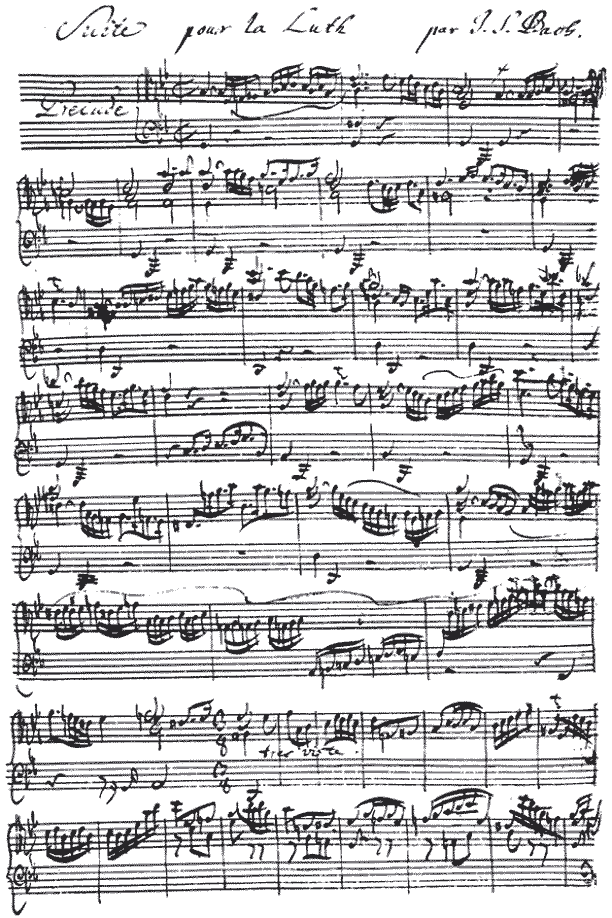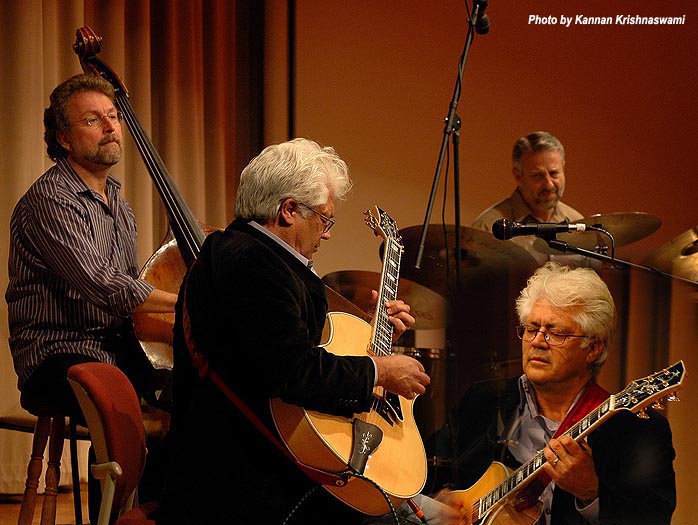|
|
|
|
|
This review page is supported in part by the sponsors whose ad banners are displayed below
|
|
 |
|
| Melody, rhythm and tempo are musical terms that describe how musical notes flow over time. Harmony describes the interactions between musicians around the melody over time. The British HiFi press often discusses the performance of HiFi gear as how well it can reproduce these motional aspects of recorded music and the interplay between musicians in time by using the catch phrase "pace, rhythm and timing" - or PRaT for short. And there's a good reason for that distinction because music is notated in time and speed and HiFi gear's ability to portray the speed and interplay aspects of music over time are crucial to providing an engaging musical experience in the listening room. Take a look at the accompanying image of the hand-written score by Bach. Even if you are not familiar with musical notation, you can still get a sense of the sweeping waves and flow of the music in time just by looking at the musical notation as it moves across the page. |
|
|
 |
|
|
HiFi gear varies a lot in its ability to be articulate and expressive in the time and interplay realm. Some brands like Naim specialize in highlighting the time aspect of music reproduction by portraying a distinct beat and the feeling of the motion in the music as part of the overall presentation. With Naim you'll always be sure to get the 'beat' of the Beatles. HiFi equipment varies in how well it performs on the speed and timing elements of music just as much as it does on non-musical aspects of recordings like imaging and soundstaging. For example, melody is that tune you 'whistle while you work' that is the musical core of a song. Some equipment makes the melody come alive and with other gear it's subdued or recessed. Then there's the interplay aspect of harmony where musicians play treble and bass accompaniments to the melody. A really good system will show off how the musicians are interacting with each other as they're harmonizing the melody, with the result being that their musical virtuosity comes to life for the listener. Rhythm is the steady pulse of the chord structure of the music as it moves along over time in a song. Then there's tempo, which is the speed of the music which also serves to lend a sense of mood to the music.
|
|
 |
|
Why bring this up? Because the Leben CS660P power amplifier is the most artful performer I have ever come across at being able to portray such a balanced and vast palette of what's possible in the musical reproduction of melody, harmony, rhythm and tempo - those subtle shades of time and interplay of elements of the music-making craft between musicians that bring the music to life in the listening room. Subtleties of melodic improvisation, of the artfulness of harmonizing the melody line, the contribution of a good rhythm player and the subtle shifts of tempo on mood and feeling all come to life in ways I have never experienced before with another amplification device to this extent. The effect is to relay the musical expressiveness of the musicians' virtuosity as captured on a recording intact into your listening room in unparalleled fashion. And that is big. In fact, the performance of the Leben CS660P amplifier has opened a new window into my perceptions of how dramatically equipment can influence the musical expressiveness of recordings by either letting it all through -- as the Leben does -- or throttling it back as is the norm. The Leben CS660P was an epiphany for me into the why of musical expressiveness, which is exciting stuff for me and other music lovers.
|
|
|
 |
|
So the Leben CS660P is an extremely artful performer for getting the musical content of a recording into your listening room in unmolested fashion. It is realistic timbrally, believable perspective-wise and offers a deeply saturated sense of musical expression. But what does it sound like in the more traditional audiophile sense of that word? Is it warm or a little lean? Is it an imaging monster or just so-so? Does it produce a huge 3D soundstage or is it more 2D? How well does it capture the sense of space of a recording venue? How about dynamics?
|
|
|
|
|
If you imagine a scale of 1 to 10 where 1 is lean and bright, neutrality falls between 5 and 6 and 10 is warm and dark, then the Leben CS660P falls somewhere around 6. The TEAD Linear A would be a 4, the Pass XA30.5 somewhere around 7, the Shindo Cortese around 8 or 9. That's an imperfect comparison of course but hopefully it gives you a relative idea of where the Leben CS660P falls sonically in the scheme of things. The CS660P is leaner and brighter than the Shindo Cortese, a touch leaner and brighter than the Pass XA30.5 but warmer and darker than the TEAD Linear A. The Leben CS660P is a remarkably 'neutral' amplifier in the most complimentary sense of that word and will introduce little coloration of its own, which is probably another reason it so successfully matches a wide variety of loudspeakers so well.
|
|
 |
|
The Leben CS660P is a very natural and organic sounding amplifier from a musical perspective and very nicely balanced from the low frequencies up through the high frequencies at pretty much any volume. It is perhaps tipped up slightly in the mid bass. By way of comparison, the TEAD Linear A is also well balanced from the lows through the highs, more linear than the CS660P but not as natural or organic, having more of a discernable electronic character to it. The Shindo Cortese is also natural and organic, albeit darker and warmer than the Leben. With Shindo in the system instead of Leben, the presentation is not as evenly balanced through the low to high frequencies over volume changes. It's almost as if the Shindo gear has some sort of loudness contour built into it and when you crank up the volume, the midrange level goes up more than the highs and lows, which can make for an easy-on-the ears experience. It's probably not totally realistic in that way but a nice way to voice things and a characteristic I think a lot of people will enjoy and find endearing. The Pass XA30.5 is also very balanced throughout the frequencies like the TEAD and Leben but in spite of being a little warmer and darker than the Leben, not as natural or organic sounding. It has more electronic sheen than the Leben.
|
|
 |
|
The Leben produces a large three-dimensional soundstage with well-defined imaging, lots of body to the images and very good transparency. It is exceptional in width and good in the depth and height dimensions. When combined with the Monbrison at least, the Cortese generally produces a bigger soundstage with more distinct imaging, a larger sense of sound space and somewhat more resolution of detail through the midrange (but only the midrange). The Leben and Shindo are bested by the TEAD in reproducing the non-musical sonic aspects of a recorded performance where it is in another league altogether in transparency and detail recovery. But then, what isn't bested by the TEAD in these categories? However, TEAD gear aside, the Shindo and Leben have what I consider to be a very high level of performance in reproducing the sonic aspects of soundspace, soundstage and imaging and both present sonics in a very balanced and natural manner that lacks electronic artifice and encourages musical expression.
|
|
|
|
Conclusion
The Leben CS660P 40-watt vacuum tube power amplifier is expensive at $9500. What you get for your money is an attractive, beautifully crafted, superb sounding, eminently musical power amplifier that works well across a wide variety of loudspeakers. It is supremely flexible for tube types, allowing the owner countless hours of joy experimenting with different vacuum tubes and their overall effect on the amp's voicing. The Leben CS660P is an easy Blue Moon award winner as a high-fidelity power amplifier.
|
|
|
 |
|
The Leben CS660P (and Leben gear in general) has caused me to completely reevaluate how I think about HiFi gear performance. It opened a new window into my perceptions related to its ability to portray the musical content of recordings such as timbre, melody, harmony, rhythm and tempo and their unique contributions to overall musical expressiveness in a fashion that was unparalleled in my experience. I don't want to sell Leben short in the sonic realm as it's also very good at reproducing the sound content of recordings in terms of perspective, imaging, soundstaging, soundspace, resolution of detail, transparence and the like yet does so in a way that is utterly realistic, natural and consonant with the music.
|
|
|
 |
|
Remarkably, Mr. Hyodo the musician and Mr. Hyodo the vacuum tube electronics designer has managed to achieve a fusion of the maker of the music elements to the sound of the music elements on recordings in his HiFi electronics in a way that removes the 'schizophonia' often associated with listening to music over high performance audio systems. The result is a piece of gear that has little in the way of mechanical or electronic signatures to serve as a reminder that you are -- after all -- only listening to a recording. Instead you are able to get lost in listening to the music in a fashion akin to when listening to living and breathing musicians plying their craft. That's quite a trick in my book. One truly does only come across a product like the Leben CS660P once in a Blue Moon. Highly recommended! |
|
|
 |
|
 |
|
Quality of packing: Excellent.
Condition of component received: Perfect.
Completeness of delivery: Complete.
Quality of owner's manual: No owner’s manual provided.
Website comments: Decent website. It's a little hard to follow some of the Japanese to English translations but I got the idea.
Human interactions: Yoshi Hontani (Leben exporter) is the best person to work with I can imagine. He is expedient, courteous and helpful. The same goes for Jonathan Halpern, the US importer for Leben. A class act all the way around! |
|
|
|
 |
|
|
|
 |
|
|
|
|
 |
|
|
|
|
|
|
|
|
|
|
|
|